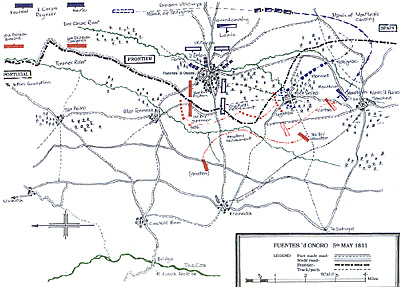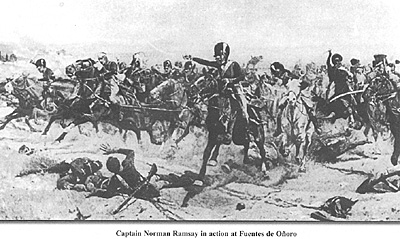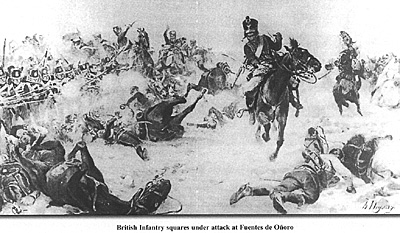Fuentes de Onoro
First in the Field and Last Out
by Raymond P. Cusick, UK
| |
Jumbo Battle Map: Fuentes de Onoro (very slow: 279K)
Craufurd marched to a wood south west of
Poço Velho keeping the riflemen to the fore to
ward off the voltigeurs, who did keep their distance
when they realised they faced rifles.
The situation was becoming critical just as the Light Division,
with Major-General Robert Craufurd back in command,
approached Poço Velho. Wellington had
ordered them south to support the 7th Division
soon after dawn with orders not to extend the Allied
flank any further to the south but cover the withdrawal
of the 7th Division back to the north.
The 7th Division had been recently formed
and in its present weak state was untried. As a
Light Division it was commanded by Major General
Houston, and had two Brigades. Sontag’s
Brigade included, the 2 / 51st Light Infantry, the
85th (Bucks) Light Infantry, the Chasseurs Britanniques
and the Brunswick Oels Jägers. Doyle’s
(Portuguese) Brigade included the 7th Portuguese
Line (2 battalions), 19th Portuguese Line (2 Battalions)
and the 2nd Cacadores. The two brigades
had a total of 6,990 men of all ranks.
Then came some fragmented action and
wild fighting during which the Chasseurs Britanniques
who were charged by French cav-alry
but in good English style fired off some
platoon volleys and drove them off. [25]
As Simmons wrote “When Greek meets Greek there comes a tug of war” adding “we were
highly amused at the recontre”. [26]
As the Light Division kept the French
infantry occupied Houston had the 7th Division
in order of close columns and were making
a gradual retreat [27] with the eccentric
Colonel Mainwaring of the 51st telling his
men “to keep in step and they cannot hurt us.”.
They moved across the higher ground protected
by allied cavalry and Bull’s troop of
Royal Horse Artillery. Although outnumbered
the light dragoons and 1st German hussars
kept up repeated harrying charges.
This situation was exactly what Sir John Moore anticipated when he planned the training for the light regiments in 1801. He insisted
that his new light regiments were to receive
the same battalion training as all line regiments
before they receive their selective light
infantry training. This would ensure that they
were totally adaptable as all-purpose light
troops and not some rag-tag-a-bob tail fringe
group of rangers.
Robert Craufurd now formed the Light
Division, which was on the plain, in battalion
columns at quarter distance ready to form
squares on command. Craufurd would then
give the command to ‘form the Square’; all the
regiments buglers would then sound the call
‘form the square’ as it echoed across the plain
it would be followed by the order that they
should face his front and March!
The mobile squares were in echelon and all faced in the
direction of the march, continuing until given
the command Halt! [28] When they all faced out
to their individual fronts presenting a wall of
bayonets to the 3,000 French cavalry, who
were constantly hovering, shouting, waving
swords and gesticulating but failing to close
in. They were all the time being attacked by
the allied cavalry, although few in number
they showed great courage.
Meanwhile Bull’s troop of guns [29] quickly unlimbered in between the squares and fired off shot to keep
the French cavalry at bay, limbering up rapidly
and galloping off. The riflemen of the
95th were extended on the flanks using cover
of outcrops and low dry-stone walls keeping
the voltigeurs at a distance, they could form
rallying squares if necessary. [30]
It was at this time that Captain Norman
Ramsay’s troop of guns who had unlimbered
and were firing off shot rapidly to keep the
French cavalry at a distance delayed too long
and were cut off and surrounded by the French.
The Light Division now had to rescue Ramsay’s
horse artillery. Ramsay ordered to limber up and
mount and at a furious gallop rode in what became
famously known as ‘the artillery charge’
through the French horsemen. With sabres
drawn and flashing of pistols charged the
French, the horses nostrils flared, eyes bulging
the race was on, the gunners heads bent over
their horses necks, limbers and 6 pounders rattling,
wheels bouncing they bounded to safety
scattering the astonished French.
Captain Brotherton’s squadron of the 14th
Light dragoons rode up at the pursuing French
cavalry and with the assistance of the Royals the
1st dragoons drove them off and captured Colonel
Lamotte and some other prisoners. Colonel
Charles Stewart, the Adjutant General led this
charge bravely which enabled Ramsay’s troop to
reach the allied lines. Meanwhile the 16th Light
dragoons and the 1st German Hussars faced with
overwhelming numbers of French cavalry rapidly
dismounted and with their mounts sought
safety in the Light divisions squares.
After a stop-start march in perfect mobile
squares covering a distance of about three miles all
reached the safety of the allied line and the Guards
opened their line to allow them to pass through. It
was textbook drill that all who witnessed it expressed
bounding praise. As John Kincaid said, “The execution of our movement presented a magnificent
military spectacle retiring through with the
order and precision of a common field day”. [31]
And no doubt Major General Robert
Craufurd’s reputation was restored and the
Coa forgiven, and this time the commanding
officers probably did drink his health. [32]
Fuentes de Onoro Light Troops in Action
|
 Earlier on the 5th [24] Wellington had seen the
moves of Solignac’s Division as well as a large
force of cavalry marching south. Wellington now
realised that he had extended his flank too thinly
and too far. Wellington ordered Cotton’s cavalry of
1,400, Bull’s troop of horse artillery and Craufurd’s
Light Division to the right to support Houston.
Earlier on the 5th [24] Wellington had seen the
moves of Solignac’s Division as well as a large
force of cavalry marching south. Wellington now
realised that he had extended his flank too thinly
and too far. Wellington ordered Cotton’s cavalry of
1,400, Bull’s troop of horse artillery and Craufurd’s
Light Division to the right to support Houston.
 Captain Norman Ramsay in action at Fuentes de Oñoro
Captain Norman Ramsay in action at Fuentes de Oñoro
 British Infantry squares under attack at Fuentes de Oñoro
British Infantry squares under attack at Fuentes de Oñoro